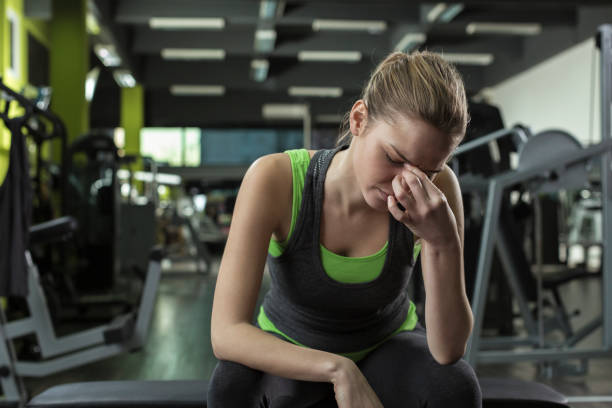We’ve all been there – the dilemma of whether to hit the gym or take a day off when battling a cold. The age-old question remains: Is working out while sick safe? Let’s dive into the intricacies of exercising during illness, exploring when it’s acceptable, the types of exercises to consider, and essential tips to keep in mind.
The Neck Rule: A Guide to Exercise During Illness
Understanding the “neck rule” is crucial when deciding whether to lace up those sneakers or stay in bed. If your symptoms are “above the neck,” such as a runny nose or mild headache, exercising is generally considered safe. However, if symptoms are “below the neck,” including chest congestion or nausea, it’s advisable to take a break from physical activity.
When to Hit Pause on Exercise
The American Heart Association (AHA) emphasizes avoiding exercise with “below-the-neck” symptoms and a fever, regardless of the cause. The rationale behind this advice is rooted in preventing potential complications like coordination problems, heart concerns, and the risk of spreading illness.
Safe Exercises for the Sniffles
1. Dance Your Way to Wellness
Cardio dance classes or simply dancing to your favorite tunes can be a safe and enjoyable form of exercise during mild illnesses. Studies suggest that dance can reduce stress levels, potentially enhancing immune function.
2. Jogging Through a Head Cold
For avid runners, a mild head cold might not be a reason to skip a jog. Running is considered a natural decongestant, helping clear the head and make you feel more normal. However, it’s crucial to scale back the intensity and avoid running with “below-the-neck” symptoms.
3. Dive into Qigong
Qigong, a slow and mindful movement practice combining martial arts and meditation, is a low-intensity option that may support immune function and reduce inflammation.
4. Dive into the Pool – Swimming
Indoor swimming can offer a refreshing exercise option, particularly for those with allergies. The humid air in indoor pools may help open airways, but individuals with congestion or sensitivities to chlorinated water should approach with caution.
5. Gentle Strolls with Walking
Even a simple walk can prove beneficial during illness, especially if you experience sinus congestion. Walking stimulates deep breaths and can help open up nasal passages.
6. Zen Out with Yoga
Yoga, particularly gentle styles like Hatha or Iyengar, can be a soothing choice during illness. Stress-relieving techniques in yoga may contribute to reducing inflammation and supporting immune function.
Exercise Caution: General Tips for Working Out While Sick
While certain exercises may be deemed safe during illness, it’s crucial to exercise caution:
- Avoid public areas: Steer clear of gyms and crowded spaces to minimize the risk of spreading illness.
- No exercise with a fever: Exercising with a fever can lead to dehydration, headaches, and muscle pain.
- Listen to your body: If exercise worsens symptoms, it’s time to prioritize rest.
- Reduce workout intensity: Lowering the intensity of workouts prevents excessive fatigue, allowing the body to allocate energy to fight off infections.
- Stay hydrated: Sweating during exercise increases the risk of dehydration, which can worsen symptoms.
Allergies: A Twist in the Tale
Sometimes, what seems like a cold might be allergies in disguise. Factors to consider for exercising with allergies include location, time of day, and weather conditions. After a workout, showering and using saline rinses can help alleviate symptoms triggered by allergens.
Gradual Return to Exercise
It’s essential to recognize the significance of a gradual return to your regular exercise routine after an illness. Rushing back into intense workouts too soon can have detrimental effects on your health and may lead to complications.
Patience is a Virtue
Experts unanimously agree that waiting until the infection has fully cleared is paramount before resuming your regular exercise regimen. Jumping back into high-intensity workouts prematurely, especially with a lingering fever, may pose risks such as coordination problems, heart concerns, and a potential loss of muscle endurance and strength.
Potential Complications and Risks
Working out with a fever, in particular, has been linked to complications like rhabdomyolysis, a condition where muscle content is released into the bloodstream. This can have serious consequences, including muscle pain, weakness, and even kidney damage. Additionally, exercising while still contagious can contribute to the spread of illness, a consideration heightened in the context of contagious viruses such as COVID-19.
Post-COVID Exercise Guidelines
For those recovering from COVID-19, the Centers for Disease Control and Prevention (CDC) provides specific guidelines. If you have symptoms, it is advised to stay away from others for at least 11 days after testing positive. However, if you are symptom-free after five days, you may gradually resume normal activities, including exercise. This cautious approach aims to prevent the potential spread of the virus.
Rebuilding Strength: A Strategic Approach
Illness often takes a toll on physical strength, and the path to rebuilding it requires a strategic and patient approach. Rather than diving straight back into your usual workout routine, consider starting with low-impact exercises and gradually increasing intensity as your strength returns.
Consultation with Healthcare Providers
If you experience new symptoms or complications while resuming exercise post-illness, it’s crucial to consult with a healthcare provider. Symptoms like persistent coughing, fatigue, or difficulty breathing during workouts may indicate underlying issues that require attention.
Crafting a Personalized Plan
One size does not fit all when it comes to post-illness exercise. Your individual recovery journey may vary based on the severity of the illness, your overall health, and other factors. Working closely with healthcare professionals, including physicians and fitness experts, can help you craft a personalized plan that promotes recovery without compromising your well-being.
